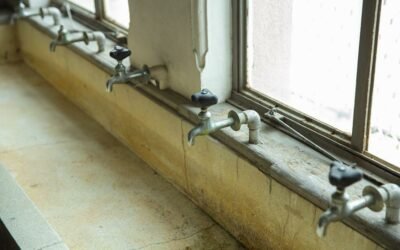Are you curious about whether mold is abiotic or biotic? In this article, we will delve into the scientific world of mold to explore its true nature.
Mold, a common type of fungus, possesses unique characteristics and interacts with the environment in intriguing ways. By understanding mold's reproductive processes and its impact on health, we can gain a deeper understanding of whether it falls into the abiotic or biotic category.
So, let's embark on this scientific journey to unravel the mystery of mold.
Key Takeaways
- Mold is a type of fungus that belongs to the kingdom Fungi and is therefore biotic.
- Mold plays a crucial role in breaking down organic matter and recycling nutrients in the environment.
- Mold reproduces through the release of spores, which can spread and initiate new growth.
- Mold requires moisture to grow and thrives in damp and poorly ventilated environments.
The Definition of Mold
When discussing the definition of mold, it's important to understand its classification as a type of fungus. Mold is a multicellular organism that belongs to the kingdom Fungi. It's characterized by its filamentous structure and its ability to reproduce through the production of spores. These spores are small, lightweight structures that can be easily dispersed through the air, allowing mold to colonize new environments.
Mold plays a crucial role in the natural environment by breaking down organic matter, such as dead leaves and wood, and recycling nutrients back into the ecosystem. However, it can also become a problem when it grows indoors, as it can cause various health issues and damage to buildings.
The growth and development of mold are influenced by several factors, including temperature, humidity, and the availability of nutrients. Mold thrives in damp and poorly ventilated areas, such as basements, bathrooms, and kitchens. It can appear in different colors, including black, green, and white, depending on the species and the conditions in which it grows.
Characteristics of Mold
To understand the characteristics of mold, you should consider its appearance, growth patterns, and potential health effects.
Mold can come in various colors, including black, green, and white. It often appears as fuzzy patches or spots on surfaces such as walls, ceilings, and damp areas.
Mold thrives in moist environments and can grow rapidly under the right conditions. It reproduces by releasing spores into the air, which can then settle on other surfaces and begin new growth.
Mold can have detrimental effects on human health. When mold spores are inhaled, they can cause respiratory issues such as coughing, wheezing, and difficulty breathing. Some individuals may also experience allergic reactions, including sneezing, itchy eyes, and skin rashes. In more severe cases, exposure to certain types of mold can lead to infections or toxic reactions.
Those with weakened immune systems, allergies, or asthma are particularly vulnerable to the negative health effects of mold.
It is important to address mold growth promptly and effectively. This includes identifying and addressing the source of moisture, improving ventilation, and removing any visible mold. Professional assistance may be required for extensive mold infestations or if individuals are experiencing persistent health issues related to mold exposure.
Reproduction of Mold
Mold reproduces through the release of spores, which can spread and initiate new growth on surfaces. This method of reproduction allows mold to quickly colonize and populate new areas. The process begins when the mold produces tiny, lightweight spores. These spores are easily carried by air currents and can travel long distances. When these spores land on a suitable surface, such as damp organic material, they can germinate and grow into new mold colonies.
The release of spores is triggered by various environmental factors, such as high humidity, moisture, and nutrient availability. Mold spores are incredibly resilient and can survive in harsh conditions, including extreme temperatures and low nutrient environments. This adaptability allows mold to thrive in a wide range of habitats, from damp basements to food storage areas.
Once the spores land on a suitable surface, they can germinate within a matter of hours or days, depending on the species of mold and the conditions present. Germination involves the spore developing into a hypha, which is a branching filament that can penetrate and extract nutrients from the substrate. As the hypha grows and branches out, it forms a network known as mycelium. The mycelium is the visible part of the mold colony and is responsible for the characteristic appearance of mold.
Interactions With the Environment
Understanding the interactions mold has with its environment is essential for effective control and prevention. Mold, being a living organism, relies on its surroundings to thrive and reproduce. Here are some key interactions mold has with its environment:
- Moisture: Mold requires moisture to grow and spread. It thrives in damp and humid environments, making bathrooms, basements, and areas with water leaks particularly susceptible. Controlling moisture levels is crucial in preventing mold growth.
- Nutrients: Mold feeds on organic materials such as wood, paper, fabric, and even dust. These materials provide the necessary nutrients for mold to grow and colonize. Regular cleaning and maintenance can help remove potential food sources for mold.
- Temperature: Mold can grow in a wide range of temperatures, but it prefers warmer environments. High temperatures can accelerate mold growth, while cooler temperatures can slow it down. Maintaining a consistent temperature and proper ventilation can help control mold growth.
- Light: Mold prefers dark environments and is typically not photosynthetic. Exposure to UV light can inhibit mold growth and prevent spores from spreading. Keeping areas well-lit and allowing sunlight to penetrate can help deter mold growth.
- Airflow: Mold thrives in stagnant air, which allows spores to settle and colonize. Proper ventilation and airflow can help prevent mold growth by reducing humidity and removing airborne spores.
Understanding these interactions can aid in developing effective strategies for mold control and prevention, ensuring a healthier environment for you and your surroundings.
Mold's Impact on Health
Mold can directly affect your health by triggering various health issues when its spores are inhaled. This is especially true for individuals with respiratory conditions or weakened immune systems. The presence of mold can lead to allergic reactions such as sneezing, coughing, and itchy eyes. For those with asthma, exposure to mold can worsen symptoms, causing wheezing, shortness of breath, and chest tightness. In some cases, mold exposure can even lead to the development of respiratory infections like bronchitis or pneumonia.
In addition to these effects, some molds produce toxins called mycotoxins. These toxins can have toxic effects when inhaled, ingested, or in contact with the skin. They have been associated with a range of health problems, including neurological symptoms, immune system suppression, and even cancer.
It is crucial to address mold issues promptly to reduce the risk of health complications, especially for individuals who are more susceptible.
Conclusion
In conclusion, mold is a biotic organism that plays a significant role in the natural environment. It exhibits distinct characteristics and possesses the ability to reproduce, enabling its survival and propagation.
Through interactions with its surroundings, mold can have both positive and negative impacts on the environment and human health.
Understanding the biotic nature of mold is crucial in effectively managing and mitigating its presence and potential adverse effects.





0 Comments